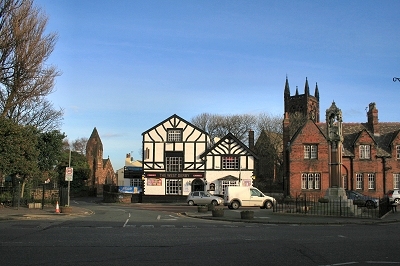 |
West Derby Village
The West Derby place-name is viking in origin. The area was attractive to early settlers as it had water from rich sandstone strata, food from the deer that proliferated (the name Derby means village with deer) and a defendable position. The area appears to have been a Roman settlement; the remains of a wooden castle where unearthed at the green on Castlesite Road behind the church in the 1930s. At the time of the Norman Conquest, West Derby was an important administrative centre when Liverpool itself was almost non-existent. The West Derby Hundred covered all of south-west Lancashire from the Ribble estuary to the whole length of the Mersey. Edward the Confessor had a castle and hunting lodge in West Derby itself. A motte and bailey castle, rivalling Lancaster castle in importance, was built in the 11th or 12th century, though it was in ruins by the early 14th century; slight traces, visible in aerial photography, once remained in a field behind St. Mary's church but have been obliterated by subsequent building. The decline in the importance of West Derby began with the rise of Liverpool following the granting of its first Charter by King John in 1207, who considered the coastal location of the latter to be strategically vital. |
 |
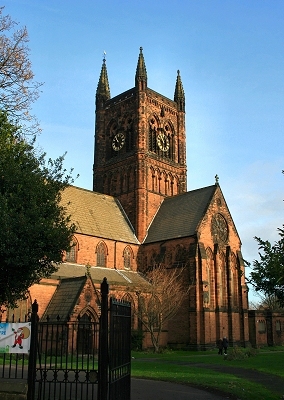 |
St. Mary's Church, West Derby Village
St. Mary's is situated in West Derby Village on the edge of the extensive open spaces of Croxteth Park. There was a church here from at least 1360, including a chapel of 1793. The present one was commisioned by Lord Sefton and designed by George Gilbert Scott on a grand scale. It was completed in 1856. |
 |
West Derby in Lewis's Topographical Dictionary of England (1848)
In the Saxon era West Derby was probably the capital of the hundred; and a mound of earth, removed some years ago by Mr. Gascoyne, indicated by its name, Castle Hill, the site of the ancient castle. The parish [...] stands on rising ground, commanding beautiful views of the surrounding country. The Zoological gardens of Liverpool are here; they occupy a pleasant site, encompassed by elevated land, and the natural features of the spot have been judiciously improved by art. The only house of early date is that, not appropriately, called New Hall, the residence for many generations of a branch of the Molyneux family; but the district abounds in elegant modern mansions and villas. [...] Tue-Brook Villa, situated three miles from Liverpool, a private asylum for insane persons in the higher ranks of society, under the management of Mr. and Mrs. Owen, is a handsome building in the Italian style, and admirably adapted for the comfort and classification of the inmates. |
West Derby in the Victoria History of the County of Lancaster (1907)
In the eighteenth century the township was divided into four quarters: Woodside, on the east; Town Row, embracing the village and the north-west portion; Low Hill, on the border of Liverpool; and Ackers End, the Old Swan district. The township lies on the edge of the open country, where the smoke-laden air of the city is exchanged for the fresher breezes which blow over open fields and through masses of foliage. True, there is hardly a break in the long line of houses from the city to the village of West Derby, but the larger houses set amidst gardens and paddocks are separated by airy spaces and are overshadowed by trees. The country is very flat, and has, except in the far east, the unmistakable stamp of suburbanism. In the easterly direction are the plantations and grounds of Croxteth Hall; in the north is open land which was once mossland, a large cemetery being a conspicuous object in the level country. South and west are more crowded with houses, where such suburban neighbourhoods as Knotty Ash, Broad Green, and Old Swan are situated. The old-fashioned village of West Derby still presents a countrified aspect in spite of the advent of electric cars, and clusters principally about the gates of Croxteth Park. The open ground is chiefly pasture, but crops of corn and potatoes are raised in a loamy soil. |
West Derby in Liverpool (1907) by Dixon Scott
[...] West Derby, a group of clean-faced cottages standing about its car-terminus like smocked village children gaping prettily at a lurid visitor, its neatly dignified church and deer-scattered park reflecting the outburst of ripe, authentic aristocracy that makes the country-side beyond so unexpectedly, so exotically, old English. |
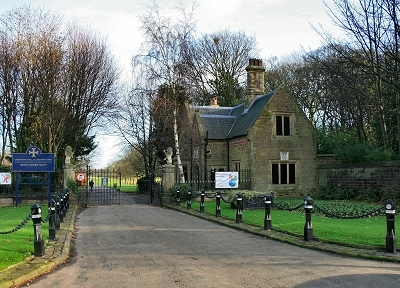 |
Croxteth Park Lodge and Gates, West Derby Village
The park gates and Elizabethan-style lodge were designed by W. Eden Nesfield and date from about 1860. |
 |
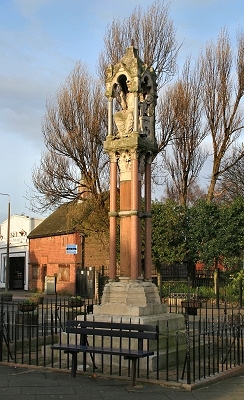 |
The Cross, West Derby Village
This elaborate Gothic cross stands on the site of the old chapel of ease to Walton and dates from the 1860s. |
 |
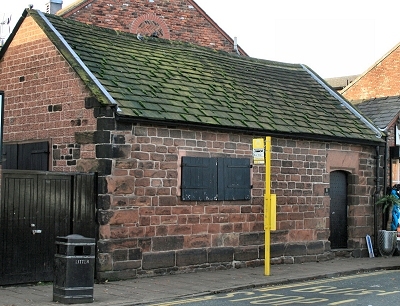 |
The Court House, West Derby Village
West Derby court house is a rare surviving example of a purpose-built manorial court complete with fittings. There has been a court house here for over 1000 years when the Vikings first arrived in the area. This one was constructed in 1586 (the fittings are 17th-18th century), making it one of the oldest intact buildings in Liverpool and the only freestanding post-mediaeval courthouse in Britain. A Wapentake (roughly the Norse equivalent of a (Hundred) court was held here every three weeks for minor offences within the West Derby Hundred. |
 |
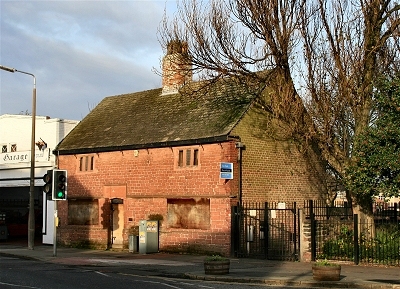 |
10 Almonds Green, West Derby Village
This house at 10 Almonds Green dates back to the 17th century. |
 |
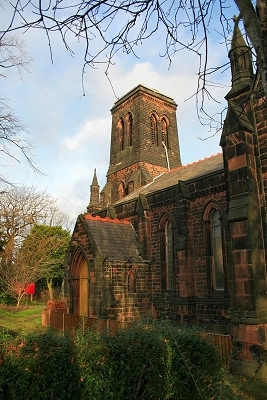 |
St. James's Church, West Derby
St. James's was built in 1845-6 to the design of E. Welch and contains some fine stained glass by Shrigley and Hunt. There was originally a spire on top of the tower. |
|
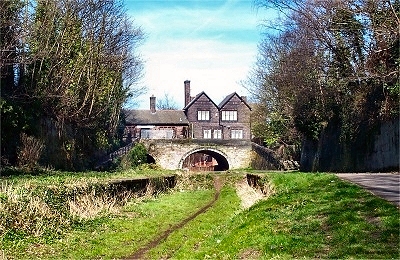 |
West Derby Station
The original station buildings and platforms still survive here at the West Derby and Clubmoor station on the dismantled Cheshire Lines railway, now the Liverpool Loop Line, a cycle track that is part of the Trans-Pennine Trail. |
 |
 |
Tunnel near West Derby Station |
 |
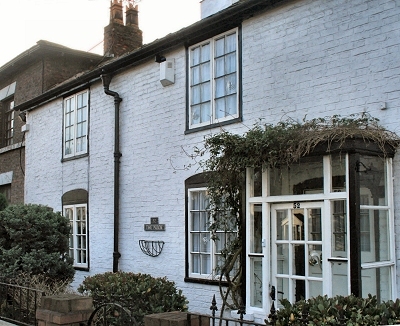 |
The Nook, West Derby
This cottage on Town Row is one of several examples of old dwellings in West Derby that have been swallowed up by modern suburbia. |
|
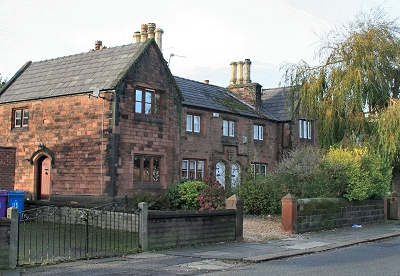 |
Cottages, West Derby
These Elizabethan-style cottages on Almonds Green were built by the Croxteth Park Estate in 1863. |
|
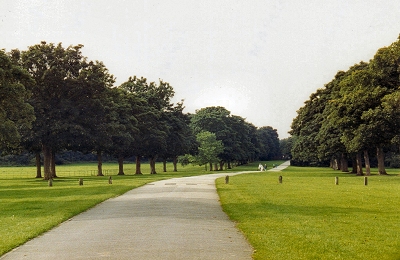 |
Croxteth Park
The 500 acre (200 ha) Croxteth Country Park is an enclave of rural England within the outer suburbs of Liverpool that also includes historic Croxteth Hall. There are huge open spaces, woodland, farmland with livestock, a model Victorian farm and miles of tracks for walking and cycling. |
 |
Croxteth Park in the Victoria History of the County of Lancaster (1907)
It is well wooded. A public footpath crosses the park, which is pleasantly carpeted with turf and shaded by good-sized trees. The woodlands have been planted with evergreen shrubs, chiefly rhododendrons, which make cover for the abundant game. The River Alt, rising in the township of Knowsley, before it attains much volume flows through the park, and finds its way through the most level of country into the sea at Hightown. Beyond the confines of the park there are wide open fields, some pasture, but the majority arable, where some of the finest Lancashire potatoes are grown. Corn and turnips also are successfully cultivated in the rich loamy soil. |
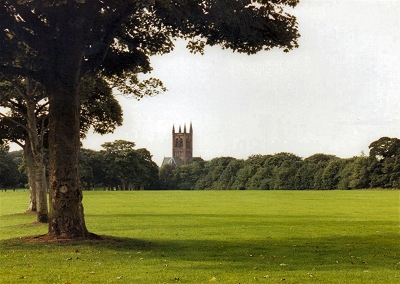 |
Croxteth Park
A distant view of St. Mary's Church, West Derby, from the park. |
 |
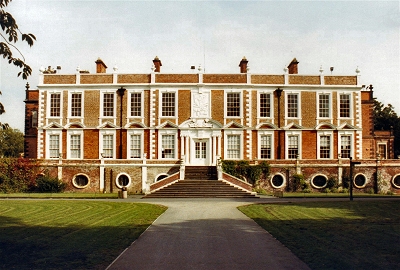 |
The Queen Anne Wing, Croxteth Hall
Croxteth Hall was the property of the Molyneux family, the Earls of Sefton, from ca.1475 until the death of the last earl in 1972. Following the completion of the Queen Anne (South) Wing, the most attractive part of the house, and the demolition of Sefton Hall in 1702, it became their principal seat. |
 |
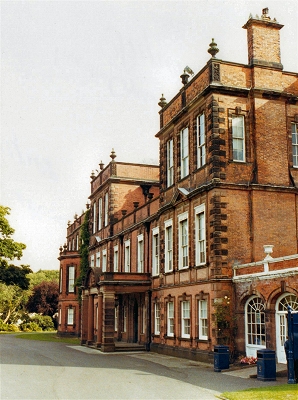 |
The Edwardian Wing, Croxteth Hall
The Edwardian (West) Wing replaces earlier building extensions ca. 1760, 1805 and 1870. The present wing, designed by J. McVicar Anderson and completed in 1904, now incorporates the main entrance. |
 |
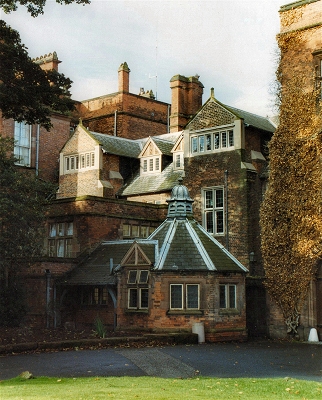 |
The Elizabethan House, Croxteth Hall
This is all that remains of the original Elizabethan house built by Sir Richard Molyneux in about 1575-1600, which could be the one of the earliest known brick buildings in Lancashire. It has been rather overwhelmed by subsequent developments. |
 |
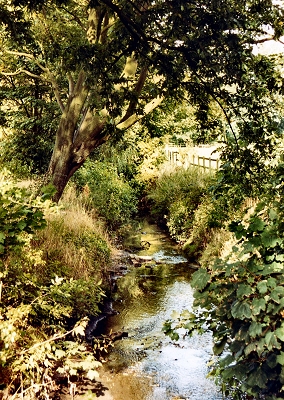 |
The River Alt at Croxteth Park
The name Croxteth is Viking in origin, meaning Krokr's landing place. Vikings are thought to have sailed up the River Alt and peacefully established a settlement here in the 10th century. Much of the land in south-west Lancashire was of poor quality and relatively unihabited until then. Looking at the river now, it is hard to imagine Viking ships here, but up to a few hundred years ago, before the construction of flood gates near the estuary and the expansion of Liverpool depleted the water supply at both ends, it was a much more substantial waterway. |
 |
